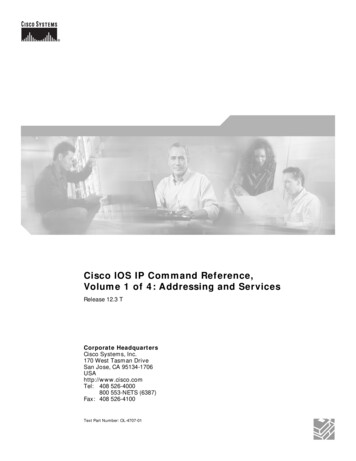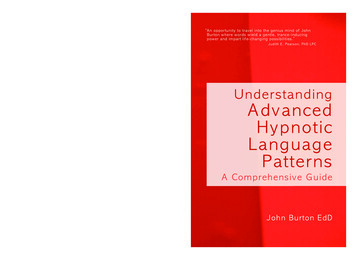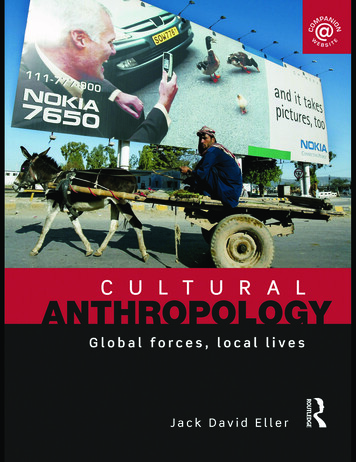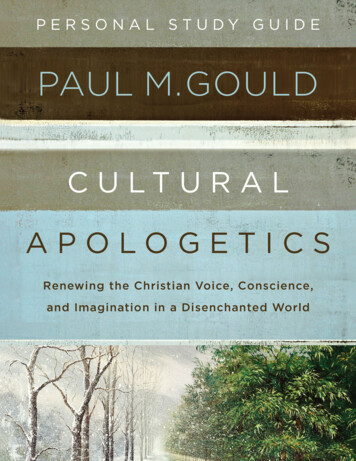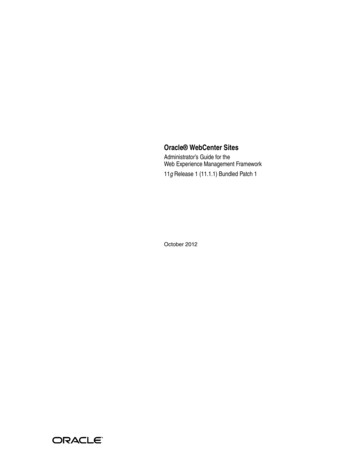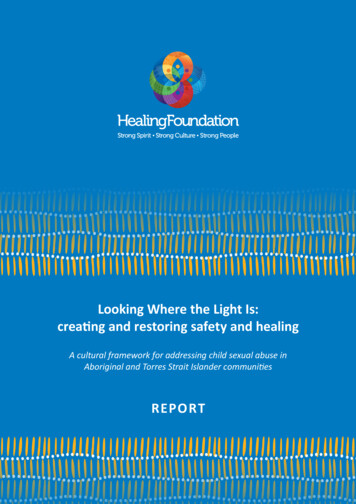
Transcription
Looking Where the Light Is:creating and restoring safety and healingA cultural framework for addressing child sexual abuse inAboriginal and Torres Strait Islander communitiesREPORT
AcknowledgementsWe pay tribute to our Knowledge Circle members whose knowledge and experience has guided thiswork. Their dedication to bringing to light the issue of child sexual abuse and their tireless work increating healing for Aboriginal and Torres Strait Islander survivors, families and communities is inspiring.This paper was written by Professor Helen Milroy, Rowena Lawrie and Paul Testro, on behalf of The Healing Foundation.Knowledge Circle members:Laurel SellersIvy TravellionDonna HensonRob HallDebra BennetGary FosterSid WilliamsToni CashGabriel BaniJoan DicksonFred BingeVirginia SlatteryDarryl HenryMerle ConyerLou TurnerSarah KanaiAcademic friends:Professor Fiona ArneyDr Tim MooreProfessor Darryl HigginsDr Antonia Quadara2
Contents1. Introduction. . . . . . . . . . . . . . . . . . . . . . . . . . . . . . . . . . . . . . . . . . . . . . . . . . . . . . . . . . . . . . . . . 42. Context. . . . . . . . . . . . . . . . . . . . . . . . . . . . . . . . . . . . . . . . . . . . . . . . . . . . . . . . . . . . . . . . . . . . . 5a. Nature and impact of child sexual abuse . . . . . . . . . . . . . . . . . . . . . . . . . . . . . . . . . . . . . . . . . . . 5b. Causes of sexual abuse . . . . . . . . . . . . . . . . . . . . . . . . . . . . . . . . . . . . . . . . . . . . . . . . . . . . . . 6c. Gaps in current approaches . . . . . . . . . . . . . . . . . . . . . . . . . . . . . . . . . . . . . . . . . . . . . . . . . . . . 83. A framework for creating and restoring safety . . . . . . . . . . . . . . . . . . . . . . . . . . . . . . . . . . . . . 94. A values led approach . . . . . . . . . . . . . . . . . . . . . . . . . . . . . . . . . . . . . . . . . . . . . . . . . . . . . . . . 105. Key elements . . . . . . . . . . . . . . . . . . . . . . . . . . . . . . . . . . . . . . . . . . . . . . . . . . . . . . . . . . . . . . . 13a. Community led responses . . . . . . . . . . . . . . . . . . . . . . . . . . . . . . . . . . . . . . . . . . . . . . . . . . . . 14b. A holistic approach . . . . . . . . . . . . . . . . . . . . . . . . . . . . . . . . . . . . . . . . . . . . . . . . . . . . . . . . 14c. Connecting to cultural values and systems . . . . . . . . . . . . . . . . . . . . . . . . . . . . . . . . . . . . . . . . . . 15d. Healing . . . . . . . . . . . . . . . . . . . . . . . . . . . . . . . . . . . . . . . . . . . . . . . . . . . . . . . . . . . . . . . 16e. Justice and reparation . . . . . . . . . . . . . . . . . . . . . . . . . . . . . . . . . . . . . . . . . . . . . . . . . . . . . . 18f. Knowledge creation and sharing . . . . . . . . . . . . . . . . . . . . . . . . . . . . . . . . . . . . . . . . . . . . . . . . 196. Strategies at the individual, family and community levels. . . . . . . . . . . . . . . . . . . . . . . . . . . 207. Conclusion . . . . . . . . . . . . . . . . . . . . . . . . . . . . . . . . . . . . . . . . . . . . . . . . . . . . . . . . . . . . . . . . . 228. References . . . . . . . . . . . . . . . . . . . . . . . . . . . . . . . . . . . . . . . . . . . . . . . . . . . . . . . . . . . . . . . . . 233
1. IntroductionIn 2016, in response to the Royal Commission into Institutional Responses to Child Sexual Abuse, The Healing Foundationreleased a discussion paper titled Restoring our Spirits – Reshaping our Futures. It set out a culturally based healing frameworkfor understanding and responding to trauma experienced by Aboriginal and Torres Strait Islander people who were sexuallyabused as children within public and private institutions. A range of recommendations were made to create change at acommunity, family and individual level to address the ongoing impacts of trauma stemming from institutional abuse. One of therecommendations was for The Healing Foundation to develop culturally based healing responses to protect children who havebeen sexually abused from further harm and to address the needs of perpetrators of child sexual abuse to stop the cycle ofintergenerational abuse.In responding to this recommendation, The Healing Foundation brought together a Knowledge Circle of key Aboriginal andTorres Strait Islander service providers and survivors along with relevant non-Indigenous practitioners and researchers. TheKnowledge Circle shared cultural, practice and research knowledge related to understanding, preventing and responding tochild sexual abuse.This paper sets out a culturally based practice framework for understanding and responding to child sexual abuse. Theframework is designed to create and restore safety and healing for Aboriginal and Torres Strait Islander children, families andcommunities. It takes a holistic view of sexual abuse in terms of its causes and impacts on children, families, perpetrators andcommunities and proposes an integrated response to the complex challenges of those causes and impacts.The concept of creating and restoring safety and healing connects the present with the past and future. It draws upon theenduring strength and resilience of Aboriginal and Torres Strait Islander cultures to drive safety and healing for children, familiesand communities along with relevant literature on child sexual abuse, trauma and healing.The framework addresses: the context of child sexual abuse and gaps in current approaches to addressing it values led approaches key elements and strategies for creating and restoring safety and healing4
2. Contexta. Nature and impact of child sexual abuseDefinitions of child sexual abuse differ across Australian jurisdictions according to government policy and legislation. Variationsoccur in relation to age, consent, the nature of the behaviours and the relationship between the victim and perpetrator.There is therefore no consistent definition of child sexual abuse that covers all behaviours, relationships between victims andperpetrators, and contexts in which it occurs.The World Health Organization (1999, in Quadara, Nagy, Higgins and Siegel, 2015) defines child sexual abuse as:The involvement of a child in sexual activity that he or she does not fully comprehend, is unable to give informedconsent to, or for which the child is not developmentally prepared and cannot give consent, or that violates thelaws or social taboos of society. Child sexual abuse is evidenced by this activity between a child and an adult oranother child who by age or development is in a relationship of responsibility, trust or power, the activity beingintended to gratify or satisfy the needs of the other person. This may include but is not limited to: the inducement or coercion of a child to engage in any unlawful sexual activity the exploitative use of a child in prostitution or any unlawful sexual activity the exploitative use of a child in a pornographic performance and materials (p.62).Child sexual abuse occurs in a range of relationships and circumstances including: abuse by a parent or family member abuse by a person known to them within the community (e.g. someone in a position of authority in sport and recreationactivities, school, church, out of home care) abuse by a strangerChildren or young people themselves may also engage in harmful sexual behaviour with other children and young people.There are difficulties in defining what constitutes harmful or sexual behaviour due to the age and development of the childreninvolved, the age at which children are considered ‘culpable’, and concerns about the impact of labelling children (El Murr, 2017;Shlonsky, Albers, Tolliday, Wilson, Norvell and Kissinger, 2017). Ell-Murr (2017) provides the following definitions:Problem sexual behaviours - applies to children under 10 years old, who are below the age of criminalresponsibility. It describes sexual behaviour or behaviours that are outside the typical range for age and/or stage of development of children.Sexual abusive behavior - applies to children and young people aged 10 to less than 17 years old, that is,the cohort still defined by the criminal law to be minors but who have reached the minimum age of criminalresponsibility.Child sexual abuse and the resulting trauma can affect a child’s immediate and longer term physical and mental health,behaviour and development. Impacts include: anxiety, depression and other mental health issuesphysical health issues, immediate and ongoingself-harm and suiciderisk taking behaviours, including alcohol and substance useneurodevelopmental impactseducation and workforce participationdifficulties with personal relationships and parentingsubsequent abuse in childhood and/or adulthood5
The child or adult’s experience of disclosing sexual abuse to others will also contribute to these impacts by either supportingtheir safety and recovery or adding to their trauma. Where children have not been believed, research and clinical experienceindicates this is extremely distressing and potentially re-traumatising, with lifelong negative impacts.The impact of child sexual abuse is broader than the child themselves. It can affect families, communities, cohesion and culturein the following ways: trauma to the non-offending parent, siblings and other family members rekindling of undisclosed or unresolved trauma in others shame to family and community members impaired parenting capacity of non-offending parent conflict and breakdown in family and community relationships economic hardship disconnection from culture and diminished participation in cultural processesSimilarly, the perpetrator and their family and community can be impacted by the abuse in the following ways: shame to family and community members conflict and breakdown in family and community relationships disconnection from culture and diminished participation in cultural processes criminal sanctions, including imprisonment banishment from the communitySome perpetrators have also been victims of child sexual abuse. Being named as a perpetrator may put other perpetratorswithin the family or community at risk of being discovered, which in turn may lead to family and lateral violence.Over time, the impact on individuals, families and communities can erode cultural values and processes though collectivetrauma, Intergenerational Trauma, impaired parenting ability over multiple generations, kinship conflict and behavioural issueslinked to trauma and victimisation, including violence (Anderson, Bamblett, Bromfield, Chan, Maddock, Menzies, O’Connell,Pearson, Walker, and Wright, 2017). It is therefore crucial that responses to child sexual abuse address all impacts on victims,perpetrators, families and communities.People may disclose child sexual abuse when the abuse occurs and/or later in life. Opportunities to ensure safety, address harmand prevent further harm may therefore arise at any point.Research suggests the earlier people disclose, the better their life outcomes. The trauma of holding a secret and the shame itmanifests causes immense harm. The Royal Commission into Institutional Responses to Child Sexual Abuse demonstrated thatmany Aboriginal and Torres Strait Islander people have suffered significant trauma after keeping sexual abuse to themselves formore than 20 years.This framework seeks to ensure Aboriginal and Torres Strait Islander children and families have supportive, open and safestructures that prevent sexual abuse, identify early warning signs and intervene where required. This framework will encourageearly disclosure when abuse does occur and create healing systems that prevent years of harm.b. Causes of sexual abuseChild sexual abuse involves the deliberate misuse of power and trust to exploit and harm children. A range of internal andexternal factors can influence the perpetration of child sexual abuse. Quadara, Nagy, Higgins and Siegel (2015) identify anumber of theories for how and why child sexual abuse occurs. These include Finkelhor’s Four Preconditions model, Ward’sPathways model, rational choice and situational choice theories, and situational crime prevention theories. Collectively, thesetheories identify the individual, social and situational factors that influence the sexual abuse of children. However, as notedby Quadara et al (2015), they do not address the cultural context in which sexual abuse of Aboriginal and Torres Strait Islanderchildren occurs.6
For Aboriginal and Torres Strait Islander people, the impact of colonisation on culture and family and community capacityto provide safety is a significant factor in understanding the broader context of trauma and child sexual abuse.Knowledge Circle members were clear that child sexual abuse does not belong in Aboriginal and Torres Strait Islander cultures.There is no documented evidence to indicate child sexual abuse was a problem in Aboriginal and Torres StraitIslander communities before colonisation. Evidence gathered in the course of the four inquiries does not supportthe myth that Aboriginal culture condones child sexual abuse in any way (Anderson et al, 2017 p.33).It is the storyline of the impact of colonisation – we need to write a new storyline.The story of colonisation is a story of profound trauma for Aboriginal and Torres Strait Islander people, caused by past andongoing discriminatory and disempowering practices. These include the forcible removal of children from their families,communities and culture; the denial of language and cultural expression; the introduction of disease, alcohol and drugs; andviolence and abuse.Three significant inquiries provide insight into the trauma faced by Aboriginal and Torres Strait Islander people – the RoyalCommission into Aboriginal Deaths in Custody (RCIADIC), Bringing them Home: Report of the National Inquiry into the Separationof Aboriginal and Torres Strait Islander Children from Their Families and the Royal Commission into Institutional Responses toChild Sexual Abuse. These reports identify past government policies as a major cause of current and ongoing trauma. They alsohighlight efforts to eradicate culture and the destruction of parenting practices including through the institutionalisation ofchildren in harsh, inhumane and abusive conditions.The Bringing them Home inquiry concluded that forcibly removing so many children as part of the Stolen Generations was anact of genocide contrary to the Convention on the Prevention and Punishment of the Crime of Genocide, ratified by Australia in1949. The convention specifically includes ‘forcibly transferring children of [a] group to another group’ with the intention ofdestroying the group.Tatz (2017) describes the impact of colonisation as ‘a deculturation of people who had one of the world’s best practices interms of childrearing, aged care, incest prohibition, kinship reciprocity and art recording’. Tatz argues that after missions andsettlements were closed, the structure that held these communities together fell away, and relatively ordered societies becamedisordered. ‘Values dissipated and disappeared incest prohibitions fell away and child molestation appeared Conflictresolution, always under unwritten rules to regulate harm, became murderous assaults. Reciprocity went out the window anda selfish pattern emerged. Not only homicide but suicide – unknown in Aboriginal culture and practice – began, with today’scluster of suicides the second-highest on the planet (next to Greenland).’The impacts of colonisation, the erosion of tribal authority was when the problems started.Colonisation impacts the systems that are established to deal with the issue of child sexual abuse.Abuse was taught by the colonisers.We’re all dealing with the impacts of colonisation, intergenerational and trans-generational trauma.Child sexual abuse is a manifestation of that.Generations of children were sexually abused in missions and this level of trauma became normalised. Parents who had beensexually abused as children saw their children abused and had no recourse to action. Many children also abused other children.This sometimes continued back in communities after missions closed.Anderson et al (2017) argue that the closure of missions and settlements created a vacuum which ‘is likely to have heightenedthe risks and vulnerability of Aboriginal and Torres Strait Islander children to outside perpetrators’ (p.42).7
Tribal authority to deal with offenders was not valued or sustained in western legislation, which subsequently had limitedunderstanding and strategies for dealing with child sexual abuse until after federation.Aboriginal and Torres Strait Islander peoples were colonised by a nation with very poor attachments, empathy and regardfor children’s rights. It was not until the 20th century that Australia saw significant changes in sexual offence legislation andacknowledgement of the rights of children (Boxall, Tomison and Hulme, 2014).O’Brien (2008) outlines how continuing structural factors of Indigenous disadvantage and distress constitute ongoing riskpathways to problem sexual behaviour in children. These include the intergenerational normalisation of violence; the silence,fear and shame in addressing violence; the instability of the home environment, including out of home care arrangements;family disruption and the resulting lack of role models; adverse socioeconomic conditions including poor housing andovercrowding; low levels of school engagement and performance; substance abuse; poor health and wellbeing; parentalcriminal activity and imprisonment; youth crime and detention; exposure to pornography; and the resulting trauma of allof these factors.The report by the Telethon Kids Institute (Anderson et al, 2017), titled Aboriginal and Torres Strait Islander children and childsexual abuse in institutional contexts, found:Aboriginal and Torres Strait Islander people were dehumanised and women and children sexualised.Allegations of abuse against them were denied even in the face of overwhelming evidence. While colonisationbroke up diverse and sophisticated systems of governance and lore in traditional Aboriginal and Torres StraitIslander communities, this was replaced with a western legal system that discriminated against Aboriginal andTorres Strait Islander peoples, provided little protection and actively prevented parents from caring for theirchildren (p.18).Community capacity to overcome the challenges of colonisation in general, and sexual abuse in particular, has been severelydiminished due to the breakdown of cultural structures and processes that previously prevented harm.Trauma resulting from colonisation has been transmitted across generations. The mechanisms by which this occurs include: a loss of attachment relationships with caregivers the impact on parenting and family functioning resulting parental physical and mental illness disconnection and alienation from extended family, culture and society (Milroy, 2005 in Dudgeon, Watson and Holland,2017)The transmission of trauma continues today through imposition of government policies, lack of autonomy for Aboriginaland Torres Strait Islander communities, lack of acknowledgement of cultural governance and knowledge, lack of funding forcommunity controlled organisations, lateral violence and racism. This trauma can only be resolved through a focus on selfdetermination and sovereignty.Child sexual abuse is part of everything else that is happening and has to be addressed as such.c. Gaps in current approachesWhile there have been some advances in funding culturally based healing services for Aboriginal and Torres Strait Islanderpeople, there is a continuing failure to understand the need for such services, and provide the funding required to supportsustained healing. The relationship between trauma, social and economic disadvantage and a range of social issues continues tobe misunderstood. These issues include child abuse, family violence, drug and alcohol abuse, longterm chronic illness and earlydeath (Feliti, Anda, Nordenberg, Williamson, Spitz, Edwards, Koss and Marks, 1998). The focus is often placed on symptomsrather than understanding the root cause.The ill health, breakdown in community structures and reduced life spans resulting from colonisation have distorted thepopulation pyramid in Aboriginal and Torres Strait Islander communities, with large numbers of children and not enough adultsto meet their needs. As a result many communities have not been able to adequately address the cumulative trauma they8
have endured and in some instances this has increased the risk of harm. This highlights the critical importance of working atthe community level: too often, responses are geared towards individuals or families without also addressing the communityprocesses and structures needed to support them.Aboriginal and Torres Strait Islander communities accept responsibility for addressing child sexual abuse. However, they cannotbe expected to respond to this challenge alone. Responsibility must be shared by communities and organisations, the broaderAustralian community, including mainstream organisations and state, territory and federal governments.In particular, there is a need to enable Aboriginal and Torres Strait Islander communities to exercise autonomy and dischargetheir responsibility. Changing population demographics must be considered as part of this: family safeguards have beendiminished, so the need for services to provide these functions is essential.Enabling autonomy requires governments and others to resource and support community led responses that create and restoresafety by strengthening cultural processes and structures and providing culturally based healing responses to sexual abuse. Inaddition, governments and others need to develop broader strategies and policies to address the impacts of trauma and socialand economic disadvantage in urban, rural and remote communities.It is clear that current approaches to preventing and responding to child sexual abuse are not working. Discussions with KnowledgeCircle members highlighted a number of gaps in current mainstream approaches to addressing child sexual abuse.These include: a narrow understanding of safety that focuses on immediate and physical safety rather than longterm emotional, culturaland spiritual aspects of safety a focus on identification, reporting and investigation that doesn’t sufficiently address prevention and healing over alifetime or reflect an understanding of culture as a protective factor a focus on individuals in terms of the victim and perpetrator without proper consideration of the impact on other familymembers, the community, or the intergenerational impact of trauma a focus on the role of external authorities that seek to intervene to ensure safety but in effect displace those best placed toensure safety and healing. This fails to acknowledge and enable the resources available within families and communities a failure to understand and address the historical and continuing impact of colonisation, in particular the impact oncommunities’ capacity to maintain cultural processes that previously prevented child sexual abuse a lack of research into treatment and recovery of survivors a failure by mental health services to provide culturally effective responses a lack of consistency across states and territories in criminal justice responses to child sexual abuse a lack of clarity about the use of community reparative responses in promoting perpetrator responsibility andaccountability3. A framework for creating and restoring safetyIt is time for a new approach to restoring safety and healing in Aboriginal and Torres Strait Islander families and communities.An approach that: is culturally based is values led empowers children, families and communities by building skills, confidence and resilience restores connections to cultural systems and processes is healing focused integrates cultural and clinical (or therapeutic) approaches to healing and recovery is informed by evidence can be evaluated from both a cultural and western perspective is cost effective9
4. A values led approachWe need to have a space driven by values; we need to set a direction. It needs to address the process and thenidentify a lifelong way for people to come together to talk about these issues and reinstate cultural practices.Knowledge Circle members identified eight values to drive the development of a culturally based response to child sexualabuse: safety respect empathy reciprocity unconditional positive regard for children truth empowerment hopeThese values are based on Aboriginal and Torres Strait Islander world views, which are both diverse and fluid. All communitieswould be able to understand and relate to these values within their own world ditionalpositive regardfor children10
a. SafetyBe aware of how we create safety and warmth – everything about them (children) matters.We would have increased places of safety for our children where they can seek safety.We need to create environments where children know that nothing is so bad it has to be secret – it createscommunities where people can’t ignore what’s going on.Frameworks are needed for addressing the conditions of safety for children.Safety is ensuring a child’s physical, emotional, cultural and spiritual wellbeing. Sexual abuse impacts all aspects of a child’swellbeing. All children have a right to grow up safely within their family, community and culture.b. RespectRespect for lore and culture.Respect for the people, particularly children and their families and carers.Respect for diversity. Not just cultural diversity, but diversity in responses that combines spiritual culturalunderstanding as well as therapeutic processes.Respect is accepting lore and cultures; understanding the diversity of cultures and traditions; and acknowledging everyone’sworth, dignity, roles and contributions.c. EmpathyPerpetrators as well as victims must receive appropriate support. We must be aware of unconscious bias.Work in a non-judgmental space that informs longterm sustainable healing.Empathy is understanding another person’s feelings, perspective and circumstances. It means being able to listen and respondto both victims and perpetrators without judging their attitudes or behaviours. It does not mean condoning their attitudes andbehaviours.d. ReciprocityI see stronger communities working towards stronger connections.Giving back the connection to culture – I want to see men who can face up to the challenges when they’re raisingchildren. Women who can walk proud and kids who feel safe and experience nurturing.Reciprocity is about how the individual is connected to family, clan and country; our sense of belonging; and our obligations andresponsibilities to each other. In particular, it is about our shared responsibility for raising our children.11
e. Unconditional positive regard for childrenWork should be child centred and work out to the community. The child is to be believed unconditionally.A child centred approach involves focusing on the rights and needs of children. It recognises their unique feelings andexperiences. Unconditional positive regard involves understanding children’s behaviour and supporting their developmentby setting boundaries and teaching social, moral and cultural norms.f. TruthPeople having confidence to share a story of what happened to them or what sort of hurt they’re doing toanother.It’s about truth the language of colonisation is now problematic. They don’t understand it and don’t experienceit. This dialogue needs to take place to share a history of truth. We use words now in a way that has no meaning.The importance of our nation understanding truth and the processes of colonising can’t be ignored.Truth involves bearing witness to wrongdoing and seeking acknowledgement, reparation and restoration at an individual orcollective level. It is about acknowledging and recognising suffering and survival. It can be in relation to a child whose humanrights have been violated by sexual abuse, or the individuals, groups and communities whose human rights have been violatedas a result of colonisation. It is about hearing them, standing alongside them and taking action to ensure their protection andsafety from further harm and promote healing. Truth telling can be important in restoring the individual, family and collectivenarrative.g. EmpowermentTeaching kids about believing their intuition – I knew something was wrong, I feel it here equipping youngpeople with a way to express it.Empowerment must be given back, responsibility must be given back, communities must be given leadership atthe core.Empowerment means increasing strength, control, power, choice and reliance at individual, family and community levels.h. HopeWhat keeps me going is the hope that things can change. I get really concerned that we won’t have a nextgeneration. I live in hope but we need a determined process to move forward.Hope is believing things can be better and often striving to make them better. It involves supporting others who are vulnerableand may be struggling to believe things can get better.12
5. Key elementsSafety is the centrepiece of healing. Safety has a number of dimensions; physical, emotional, social, cultural and spiritual. Sexualabuse affects all dimensions of a child’s safety and longterm development. If safety is to be restored, responses to child abuseand neglect must address each of these dimensions.The place and care of children in Aboriginal and Torres Strait Islander cultures is central to family, comm
the exploitative use of a child in a pornographic performance and materials (p.62). Child sexual abuse occurs in a range of relationships and circumstances including: abuse by a parent or family member abuse by a person known to them within the community (e.g. s



